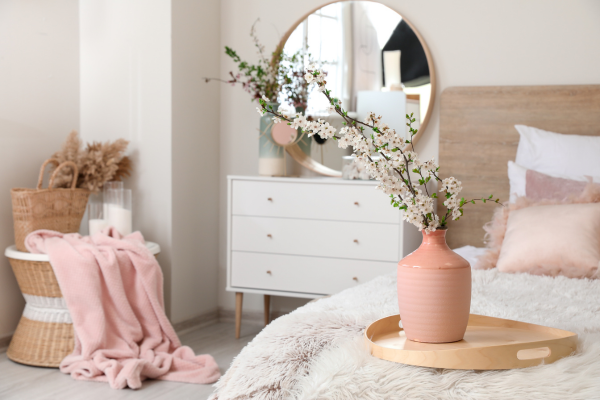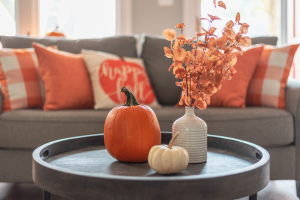Ever wondered why you feel certain emotions in particular rooms? Your bedroom’s color might be influencing your mood. This article will guide you in creating your ideal sanctuary, exploring the science of color psychology.
You’ll learn about choosing the right shades and how to implement them, along with understanding the impact of light on color perception. Let’s transform your bedroom into a serene haven that truly feels like home.

Key Takeaways
– Room ambiance and color psychology play a crucial role in mental well-being and productivity.
– Different colors evoke different emotional responses and can affect mood, energy levels, and sleep quality.
– Choosing the right colors involves considering color symbolism, cultural associations, and personal preferences.
– Lighting influences color perception, and adjustable lighting can enhance the visual impact of colors in the bedroom.
Importance of Room Ambiance
You can’t underestimate the importance of room ambiance in creating your perfect sanctuary; it plays a crucial role in determining how you feel in your space. The ambiance and productivity in your bedroom are intrinsically linked; a calm and serene environment can significantly boost your mental well-being and overall productivity.
Sensory aesthetics influence the atmosphere of a room, and it’s essential to consider this when creating your serene sanctuary. The colors you choose for your bedroom can have a profound effect on your mood, energy levels, and sleep quality. Soft, soothing shades can help to reduce stress and anxiety, promoting relaxation and restful sleep. On the other hand, bright, vibrant colors can stimulate the senses, potentially making it harder to wind down at the end of the day.
Therefore, understanding color psychology is critical when designing a tranquil retreat. Carefully selected colors can evoke feelings of comfort, warmth, and belonging, transforming your bedroom into a peaceful haven where you can truly relax and recharge. So, embrace the power of color to create a bedroom ambiance that nurtures your wellbeing and productivity.
The Science Behind Color and Mood
It’s fascinating to understand how different hues can significantly impact our mood and behavior. Delving into color symbolism, we find that each color carries a unique message that can tap into our emotional responses. Reds, for instance, are generally associated with passion and energy, while blues typically represent peace and tranquility.
The science behind this is quite intriguing. Colors are processed by our brains as electromagnetic waves, each with its own frequency. These frequencies trigger various physiological reactions, which in turn affect our mood. For example, the color green, with its mid-range frequency, is known to promote feelings of calm and relaxation, making it a popular choice for bedrooms.
When creating your serene sanctuary, it’s crucial to consider the psychological effects of color. Pastel hues like soft pinks and blues can bring a sense of calmness and belonging, while warm tones like golds and browns can make the room feel cozier and more inviting.
Remember, your bedroom is a personal haven, so choose colors that align with your emotional needs and create a space that truly feels like home.
Choosing the Right Shades
Selecting the perfect shades for your personal space isn’t just about aesthetics; it’s also about how they make you feel. Color symbolism plays a significant role in this process, as each hue has its unique psychological effects. Understanding these effects can help you curate a bedroom environment that promotes relaxation, tranquility, and overall well-being.
Consider the following aspects when choosing your bedroom color:
– Understanding color symbolism:
– Blue symbolizes calmness and stability, making it ideal for creating a peaceful ambiance.
– Green represents nature and renewal, perfect for a refreshing and invigorating environment.
– Red, although energetic, might be too stimulating for a bedroom. A softer pink may be a better choice, symbolizing love and warmth.
– Considering cultural associations:
– In some cultures, white symbolizes purity and peace, making it a popular choice for a serene sanctuary.
– Conversely, in others, white might represent mourning, so understanding these cultural nuances is essential.
– Balancing your personal preferences with the psychological effects of colors.
The shades you choose can significantly influence your mood and mindset. Therefore, it’s crucial to choose colors that not just visually appeal to you, but also contribute to a soothing and welcoming atmosphere in your bedroom. Remember, your bedroom is your sanctuary, and its colors should reflect that.
Implementing Color into Your Space
Once you’ve chosen the right shades, incorporating them into your space can be an exciting process. The key lies in understanding the principles of color combinations and palette customization. It’s not just about slapping paint on the walls; it’s about creating a space where you feel at home, a space that reflects your personality.
Experiment with different color combinations to discover what feels best for you. Remember, your bedroom is your sanctuary, so choose colors that resonate with your personality and the emotions you want to evoke. If you’re aiming for a serene and calming environment, consider cooler tones like blues and greens. Want a bit more energy? Warmer hues like reds and oranges could be your answer.
Palette customization is another crucial aspect. It allows you to create a unique color scheme that perfectly suits your style and needs. Whether you prefer a monochromatic palette or a vibrant mix of complementary colors, the choice is entirely yours.
As you implement these colors into your space, watch as your bedroom transforms. It’ll become a reflection of your personal taste, a place of comfort, tranquility, and belonging. This is the beauty of color psychology for bedrooms, it enables you to create a sanctuary that’s truly yours.
The Impact of Light on Color Perception
Don’t forget about the role of lighting in shaping your perception of the hues in your room. Both natural and artificial light can dramatically influence how you perceive color. Your color vision is affected by the intensity and shade of light, with different lighting types casting varying hues onto your walls.
Daylight, for instance, brings out the truest colors while incandescent lights bring out warmer tones and yellows. Fluorescent lights, on the other hand, can create a sharp blue tone. So, when you’re selecting colors for your bedroom sanctuary, consider the kind of light the room gets. What looks good under sunlight may not look the same under your bedside lamp.
Adjustable lighting can also play a significant role in enhancing the visual impact of your chosen colors. Dimmer switches, for example, let you control the brightness level, subtly changing the room’s color perception throughout the day and night.
Thoughtfully considering the interplay between color and light can really enhance your bedroom’s ambiance. It’s not just about picking a color you like, it’s about understanding how that color changes and interacts with light. This understanding allows you to truly create a serene sanctuary that feels like your own.
Frequently Asked Questions
How can color psychology influence our sleep patterns?
Your color perception can greatly impact your sleep. Light influence from different hues affects your mood, which in turn can alter your sleep patterns. Understanding this can help you create a more restful environment.
Can color psychology help improve mental health issues like anxiety and depression?
Yes, color psychology can help improve mental health issues like anxiety and depression. Color therapy benefits include mood enhancement and mental health improvement as certain hues can instigate feelings of calm and happiness.
How does color psychology relate to Feng Shui principles in bedroom design?
Feng Shui symbolism and color associations intertwine in bedroom design. Each color symbolizes different energies in Feng Shui, thus, your room’s colors can harmonize or disrupt energy flow, affecting your wellbeing. It’s a significant aspect of creating your own sanctuary.
Can color psychology be applied to children’s bedrooms to promote better learning or creativity?
Absolutely! Color impact on childhood behavior can be significant. Sensory stimulation through colors can enhance learning and creativity in your child’s bedroom. Choosing the right hues can foster a sense of belonging and inspiration.
Is there any correlation between an individual’s personality type and their color preference for a bedroom space?
Yes, your color preference origin can link to your personality type. This ‘Personality Color Mapping’ shows how different colors resonate with various personality traits, influencing your bedroom color choices to reflect your unique self.
Conclusion
In creating your serene sanctuary, remember, color choice is key. It’s not just about aesthetics, it’s about how colors impact your mood and overall wellbeing. Don’t underestimate the power of light either, as it drastically affects color perception.
Be mindful, thoughtful, and analytical in your design process. Your bedroom isn’t just a room, it’s a reflection of you. Make it a space that truly serves your needs.


